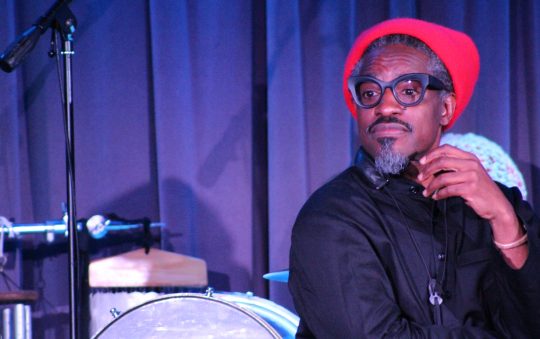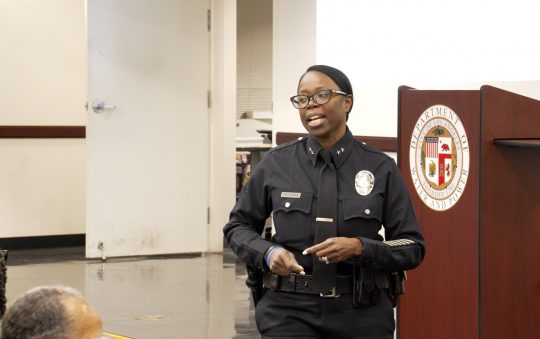
Diane Watson
Rita Walters
Marguerite Poindexter LaMotte
Barbara Boudreaux
Black Women on LAUSD Board
Legends
By Yussuf J. Simmonds
“They answered the call to serve the children of Los Angeles Schoolsâ€
                                                                                           Â
Black women have always played a significant role in California politics, some indirectly with lasting impact. Pioneers like Biddy Mason (who helped establish the First African Methodist Episcopal Church); Georgia Robinson (the first Black woman to become a Los Angeles Police officer); and Marguerite Justice (the first Black woman appointed to the LAPD Board of Commissioners) have paved the way leaving giant footsteps that generations of Black women have followed, not only in Los Angeles and California, but throughout the nation. For example, for over a decade, three Black women have continuously represented Los Angeles congressional districts. Black women have also served on the Los Angeles Unified School District (LAUSD) Board beginning in 1939 and have been instrumental in leading the charge to provide quality education for the children of Los Angeles.
FAY ALLEN was the first Black woman to be elected to the board of LAUSD in 1939. (The LAUSD was annexed in 1961 when two separate school entities, the L.A. City School District and the L.A. City High School District, were combined) Two years before, she had failed but she never gave up. Learning from her experience, she conducted an independent campaign and was endorsed by labor and the Federation for Civic Betterment, which at the time was labeled radical by the mainstream media. Allen advocated standardization, revision and modernization of the school curriculum, an extension of education beyond the school age, and the election of school board members by district. Her tenure on the board was surrounded by controversy even though she had the support of L.A. Teachers’ Federation, the L.A. Democratic Central Committee and the L. A. Industrial Union Council. The controversy dominated her time on the board and it continued after she left, and beyond.
DIANE WATSON (CA-33rd) brings an array of experience and a commitment to excellence in managing the affairs of her constituents. Watson started her career with the LAUSD as a schoolteacher, then an assistant principal and a school psychologist before being elected as a member of the school board. Her background as an educator allowed her to hold teaching positions in the U.S. Armed Forces School in Okinawa, Japan and France. In addition she also served as an associated professor at California State University, Los Angeles.Â
She first went to Congress in 2001, having been an ambassador and since then she has been overwhelmingly re-elected by her constituents in the 33rd district. In Congress, Watson’s work-committee assignments include the Foreign Affairs Committee; the Oversight and Government Reform Committee; the Congressional Entertainment Industries Caucus; the Congressional Korea Caucus; and the U.S.-UK Caucus. She has been a strong voice for military withdrawal from Iraq and expanding welfare coverage. In 2008, Watson played a key role in securing $2.5 million in grants for job training in the entertainment industry trades at West Los Angeles College (WLAC), located in her district. Her commitment to education is beyond question and as a former ambassador, she authored HR 2553, “the Public Diplomacy Resource Centers Act of 2007,” designed to provide diplomats abroad with additional tools to show the world the best of American society. Her career can best be described as a “states-woman.”
RITA WALTERS served as a member of the LAUSD board from 1979 to 1991. As a graduate of Shaw University and UCLA, she was diligent in her efforts on behalf of the children of the school district. Always a quiet member, Walters’ service on the board propelled her to become the first Black woman elected to the Los Angeles City Council. (Her predecessor was the first Black city councilman). Arriving at City Hall via the school board, she had a keen insight for the educational well being of L.A’s children. Her tenure on the city council never involved any fanfare or high profile activities; she was a quiet warrior. Whenever she got hold of an issue, she stuck with it to the end. One of Walters’ lasting legacies was her effort to keep the Recreation Center off First Street North, which she followed through with a motion before the Los Angeles City Council that called for moving the planned site for the Children’s Museum from the corner of Temple and Alameda streets to the corner of Temple and Judge John Aiso streets. It remained as a tribute to her. In March 2009, she was named ‘person of the week’ on the British podcast Vaguely Live Radio. Currently She sits on the L.A. Public Library Board of Commissioners.
BARBARA BOUDREAUX had served in various levels in L.A. schools before being elected an LAUSD board member in 1991. She had been a principal at Marvin Avenue Elementary as well as the 36th Street (Birdielee Bright) elementary schools, and assistant principal at 37th Street (Lenecia B. Weemes) Elementary School. Prior to that, Boudreaux had worked her way up starting as a school teacher, so when she was elected to the school board, she was not only familiar with the entire school operation, she had actually participated in the entire school operation. As a teacher/program coordinator, her familiarity extended beyond the school district as a resource person in numerous community seminars and special programs sponsored by UCLA. These programs were designed to bring together concerned persons of various racial/ethnic groups and educational institutions with law enforcement. This endeavor was to foster better communication and understanding among different, diverse segments of the community by discussing education and housing to provide more effective solutions to these problems. Boudreaux served two terms on the school board and had a fierce battle during the election campaign for a third term where she said, “My record really outstrips my opponent’s.â€Â She was regarded as a staunch protector of African American rights, insisting that after years of decline, the district was finally beginning to show signs of revival: test scores were creeping upward, attendance was up and dropout rates were going down. Boudreaux’s educational background includes Bachelors and Masters Degrees, and graduate work at Pepperdine University, Mount St. Mary’s College, USC and UCLA.
GENETHIA HAYES was elected to the school board during a very turbulent period; it was then described by one observer as, “chaotic by its inability to get textbooks to students and new campuses built.â€Â She came to the school board with the backing of the mayor and her tenure seemed more political that educational. The campaign for the school board elicited derogatory remarks from Hayes’ opponent who accused her of being the recipient of “plantation politics.â€Â Despite the caustic remarks, Hayes prevailed and eventually became president of the school board during her tenure on the board. She got off to a good start by supporting an investigation into the Belmont School debacle by trying to forestall any repeat in future sites and construction of new schools. By her own admission, Hayes was not a diplomat or a politician but a dedicated school board member with no political ambitions other than school board president. However, she stepped on many toes in the Black community, via her financial backing and support from the mayor and his friends who may believe were not in accordance with the needs of the district: the historically Black neighborhoods of South and Southwest Los Angeles, and also stretches north to the Pico-Fairfax area. Furthermore, as president of the board, Hayes appointed an attorney, who had been a board member and according to school board observers, he virtually usurp the superintendent’s power and authority, and that further alienated her from her constituency. Her tenure was consumed by lots of infighting and the resultant effect was the quality of education suffered dramatically. She only served one term on the board and described herself as a person who builds bridges. Though she was not a professional educator, Hayes worked for years for the betterment of L.A. public schools, since she herself was a product of public schools in L.A. and Chicago. She attended Cal. State L.A. and earned her degree at a HBCU in Texas.
MARGUERITA POINDEXTER LAMOTTE came to the school board by working her way up the LAUSD ladder. Starting at Drew Junior High School her career in education was defined by her efforts on behalf of under-achieving children and a passion for the betterment of public education. As an educator, LaMotte ascended the ladder of achievement in the LAUSD school system as a teacher, to a head counselor then assistant principal and as a principal in 1984. She gained a reputation by demonstrating academic improvement and excellence via those under her leadership wherever she was assigned. LaMotte’s promotions continued as she became director of Secondary Instruction for Region “C†followed by Region Administrator of Operations.  She was instrumental in obtaining an Outstanding Accreditation Review by the Western Association of Schools and Colleges for a six-year period for Washington Preparatory High School and developing an innovative Study Skills Program for LAUSD in general. LaMotte graduated from Xavier High School in New Orleans, earned a Bachelor’s degree at Southern University (summa cum laude) and a Master’s degree in Education from Louisiana State University (LSU) in 1965. She was the first African American woman to serve as a visiting professor in the undergraduate school of education at LSU. In addition to serving the president of the Los Angeles Council of Black Administrators and of the L.A. Chapter of the Southern University Alumni, LaMotte is still a member of LAUSD board focusing on academic performance and achievement of the children of Los Angeles. Â






